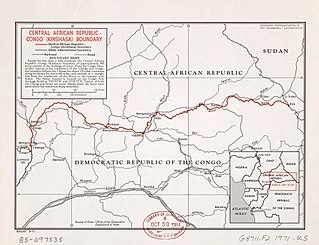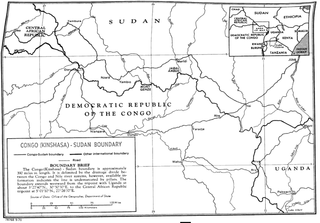
The history of the Republic of the Congo has been marked by diverse civilisations: Indigenous, French and post-independence.

Leopold II was the second King of the Belgians from 1865 to 1909, and the founder and sole owner of the Congo Free State from 1885 to 1908.

The Belgian Congo was a Belgian colony in Central Africa from 1908 until independence in 1960 and became the Republic of the Congo (Léopoldville). The former colony adopted its present name, the Democratic Republic of the Congo (DRC), in 1964.

The Congo Free State, also known as the Independent State of the Congo, was a large state and absolute monarchy in Central Africa from 1885 to 1908. It was privately owned by King Leopold II, the constitutional monarch of the Kingdom of Belgium. In legal terms, the two separate countries were in a personal union. The Congo Free State was not a part of, nor did it belong to Belgium. Leopold was able to seize the region by convincing other European states at the Berlin Conference on Africa that he was involved in humanitarian and philanthropic work and would not tax trade. Via the International Association of the Congo, he was able to lay claim to most of the Congo Basin. On 29 May 1885, after the closure of the Berlin Conference, the king announced that he planned to name his possessions "the Congo Free State", an appellation which was not yet used at the Berlin Conference and which officially replaced "International Association of the Congo" on 1 August 1885. The Free State was privately controlled by Leopold from Brussels; he never visited it.

The Berlin Conference of 1884–1885 met on 15 November 1884 and, after an adjournment, concluded on 26 February 1885 with the signature of a General Act regulating European colonization and trade in Africa during the New Imperialism period.

King Leopold's Ghost: A Story of Greed, Terror and Heroism in Colonial Africa (1998) is a best-selling popular history book by Adam Hochschild that explores the exploitation of the Congo Free State by King Leopold II of Belgium between 1885 and 1908, as well as the large-scale atrocities committed during that period. The book, also a general biography of the private life of Leopold, succeeded in increasing public awareness of these crimes in recent decades.
Colonization of the Congo Basin refers to the European colonization of the Congo Basin of tropical Africa. It was the last part of the continent to be colonized. By the end of the 19th century, the Basin had been carved up by European colonial powers, into the Congo Free State, the French Congo and the Portuguese Congo.

The Royal Museum for Central Africa (RMCA), communicating under the name AfricaMuseum since 2018, is an ethnography and natural history museum situated in Tervuren in Flemish Brabant, Belgium, just outside Brussels. It was originally built to showcase King Leopold II's Congo Free State in the International Exposition of 1897.

Belgium controlled several territories and concessions during the colonial era, principally the Belgian Congo from 1908 to 1960, Ruanda-Urundi from 1922 to 1962, and Lado Enclave from 1884 to 1910. It also had small concessions in Guatemala (1843–1854) and Belgian concession of Tianjin in China (1902–1931) and was a co-administrator of the Tangier International Zone in Morocco.

The International Association of the Congo, also known as the International Congo Society, was an association founded on 17 November 1879 by Leopold II of Belgium to further his interests in the Congo. It replaced the Belgian Committee for Studies of the Upper Congo which was part of the International African Association front organisation created for the exploitation of the Congo. The goals of the International Congo Society was to establish control of the Congo Basin and to exploit its economic resources. The Berlin Conference recognised the society as sovereign over the territories it controlled and on August 1, 1885, i.e. four and half months after the closure of the Berlin Conference, King Leopold's Vice-Administrator General in the Congo, announced that the society and the territories it occupied were henceforth called "the Congo Free State".

There was a worldwide media propaganda campaign waged by both King Leopold II of Belgium and the critics of the Congo Free State and its atrocities. Leopold was very astute in using the media to support his virtual private control of the Congo. British campaigner Edmund Dene Morel successfully campaigned against Leopold and focused public attention on the violence of Leopold's rule. Morel used newspaper accounts, pamphlets, and books to publish evidence from reports, eye-witness testimony, and pictures from missionaries and others involved directly in the Congo. As Morel gained high-profile supporters, the publicity generated by his campaign eventually forced Leopold to relinquish control of the Congo to the Belgian government.

The Brussels Anti-Slavery Conference of 1889-1890 was held from 18 November 1889 to 2 July 1890 in Brussels and concluded with the adoption of the Brussels Conference Act of 1890 on the prohibition of slave trade and slavery in Africa. The convention favoured colonial policies, justified by the anti-slavery argument. The event and its origins were shaped primarily by a narrow national interest. Governments paid lip-service to humanitarian goals in order to legitimize their imperial aims.

From 1885 to 1908, many atrocities were committed in the Congo Free State under the absolute rule of King Leopold II of Belgium. These atrocities were particularly associated with the labour policies, enforced by colonial administrators, used to collect natural rubber for export. Combined with epidemic disease, famine, and falling birth rates caused by these disruptions, the atrocities contributed to a sharp decline in the Congolese population. The magnitude of the population fall over the period is disputed, with modern estimates ranging from 1.5 million to 13 million.

The Central African Republic–Democratic Republic of the Congo border is 1,747 km in length and runs from the tripoint with the Republic of the Congo in the west to the tripoint with South Sudan in the east.

The Democratic Republic of the Congo–South Sudan border is 714 km in length and runs from the tripoint with the Central African Republic in the west to the tripoint with the Uganda in the east.

Congolese nationality law is the nationality law for the Democratic Republic of the Congo. It is regulated by the Constitution of the Democratic Republic of the Congo, as amended; the Congolese Nationality Code, and its revisions; the Congolese Civil Code; and various international agreements to which the country is a signatory. These laws determine who is, or is eligible to be, a national of the Democratic Republic of the Congo.

Les Belges dans l'Afrique Centrale. Voyages, aventures et découvertes d'après les documents et journaux d'explorateurs is a travel account composed of three volumes about the early years of the colonization of the Congo basin by Léopold II, which was published several times as both books and instalments between 1884 and 1893. The first volume was written by Adolphe Burdo (1849-1891) and subtitled De Zanzibar au Lac Tanganika. The second and third were written by Charles de Martrin-Donos (1857-1904) and subtitled Le Congo et ses affluents. The volumes were written to "popularize and glorify the civilizing African enterprise, and the Belgians who took part in it".

Charles Adolphe Marie Liebrechts was a Belgian soldier, explorer and administrator in the Congo Free State.
Anthony Bannister Swinburne was a British explorer and ivory trader who served as an assistant to Henry Morton Stanley. He is known for developing the Léopoldville station, later to become the city of Kinshasa.
The Committee for Studies of the Upper Congo, or in French the Comité d'études du Haut-Congo, was formed in 1878 on behalf of Leopold II, King of the Belgians, as part of the Scramble for Africa.
















